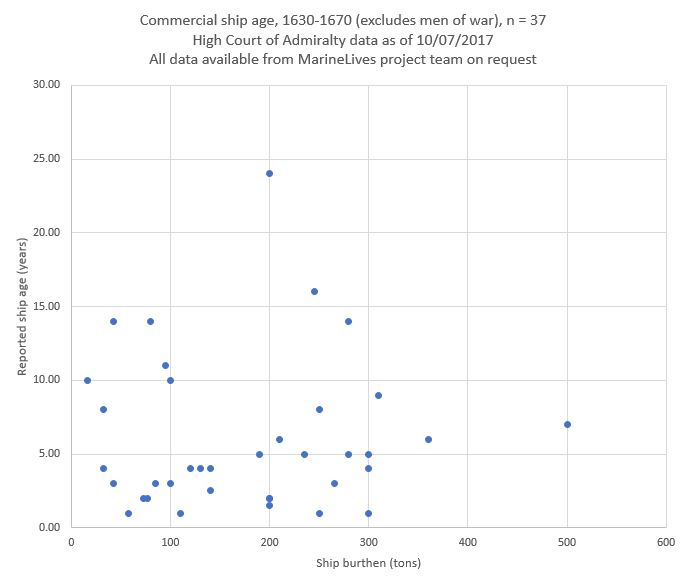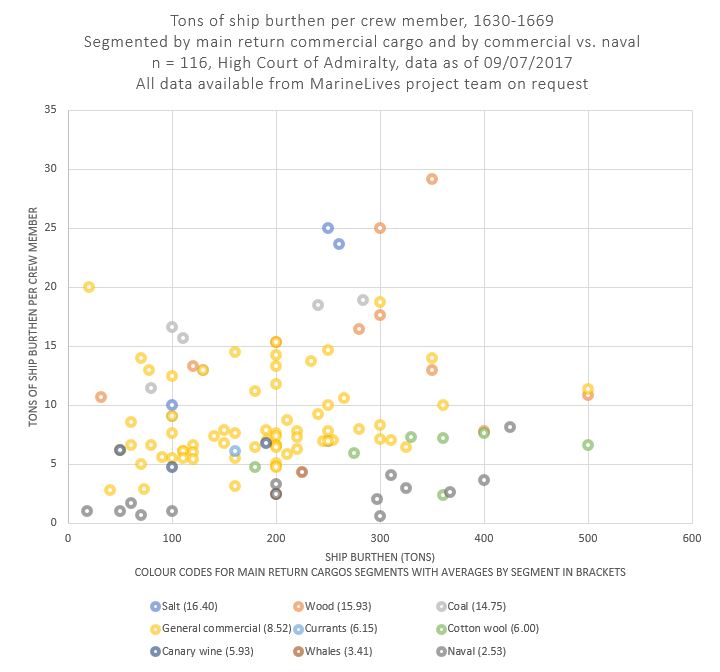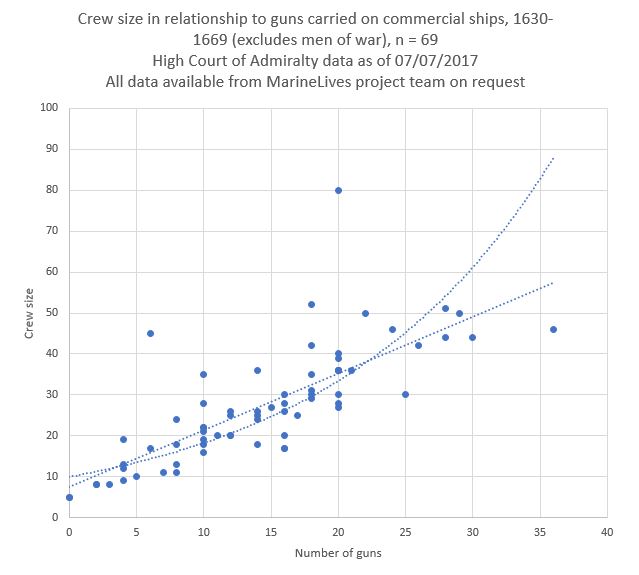Difference between revisions of "MarineLives"
| Line 144: | Line 144: | ||
<div style="padding: 10px;"> | <div style="padding: 10px;"> | ||
<div style="font-famil:Garamond; font-size: normal;">'''The size of our dataset for the analysis of tons of ship burthen per crew member is one hundred and sixteen. We have crew size data for one hundred and seventy-two ships, but lack ship burthen data in tons for fifty-six of these.'''</div> | <div style="font-famil:Garamond; font-size: normal;">'''The size of our dataset for the analysis of tons of ship burthen per crew member is one hundred and sixteen. We have crew size data for one hundred and seventy-two ships, but lack ship burthen data in tons for fifty-six of these.'''</div> | ||
| − | |||
The average crew size for the larger dataset is 47.3, including six exceptionally manned men of war with 275 or more men per ship (n = 172). The average crew size for the smaller dataset, where we have crew number and ship tonnage is 36.5 (n=116). | The average crew size for the larger dataset is 47.3, including six exceptionally manned men of war with 275 or more men per ship (n = 172). The average crew size for the smaller dataset, where we have crew number and ship tonnage is 36.5 (n=116). | ||
| Line 156: | Line 155: | ||
<div style="padding: 10px;"> | <div style="padding: 10px;"> | ||
<div style="font-famil:Garamond; font-size: normal;">'''The size of our dataset for the analysis of crew size and gun number is sixty-nine, where we have both crew size and gun number. We have crew size data for one hundred and seventy-two ships in total and have gun number for one hundred and seventy-nine ships. Twenty-seven of the ships for which we have crew size are men of war and one hundred and forty-five are commercial ships. Forty-two of the ships for which we have gun number are men of war and one hundred and thirty-seven are commercial.'''</div> | <div style="font-famil:Garamond; font-size: normal;">'''The size of our dataset for the analysis of crew size and gun number is sixty-nine, where we have both crew size and gun number. We have crew size data for one hundred and seventy-two ships in total and have gun number for one hundred and seventy-nine ships. Twenty-seven of the ships for which we have crew size are men of war and one hundred and forty-five are commercial ships. Forty-two of the ships for which we have gun number are men of war and one hundred and thirty-seven are commercial.'''</div> | ||
| − | The average gun number for just men of war is 22.4. The average gun number for just commercial ships is 12.8. | + | The average gun number for just men of war is 22.4 (n=2). The average gun number for just commercial ships is 12.8 (n=137). Our sample of commercial ships where we have tonnage as well as gun number (n=69) has a slightly higher average gun number than for all commercial ships, where gun number is known. |
| + | |||
| + | The commercial gun number average overestimates the gun carrying propensity of commercial ships, since there is a systematic tendency not to report absence of guns from smaller vessels (vessels of thirty to sixty tons burthen). Many of these vessels, particularly those involved in coastal trade or fishing, as hoys, busses and ketches, would not have carried guns. | ||
[[File:Guns Crew Size 07072017.JPG|600px|thumbnail|left|]] | [[File:Guns Crew Size 07072017.JPG|600px|thumbnail|left|]] | ||
Revision as of 13:11, July 10, 2017
Our volunteers
MarineLives is a collaborative volunteer driven project. The project started as a spinoff from a National Archives hackathon in early 2012. We are dedicated to the collaborative transcription, linkage and enrichment of primary manuscripts from the High Court of Admiralty, 1650-1669 (with some excursions into data from the 1630s and 1640s).
Currently, we have just over 10,000 images available (29 GB) and 11,400 pages of full text transcriptions on the MarineLives wiki.
Please contact us if you would like to learn more about this summer's project and how you can help, or if you would more generally like to learn about the work of MarineLives volunteers.
We would like to recognise and thank all those who have contributed to our project (in alphabetical order), whether as volunteer transcribers, annotators, commentators, advisors, interviewees, or PhD Forum participants.
Dr Aquiles Alencar-Brayner
Dr Roberta Anderson
Deborah Ashby
Rachel Bates
Rowan Beentje
Dr Richard Blakemore
Lior Blum
Katie Broke
Dr James Brown
Dr Andy Burn
Elio Calcagno
Michelle María Early Capistrán
Rachel Carter
Giovanni Colavizza
Dr Justin Colson
Thierry Daunois
Dr John Davies
Thomas Davies
Jonathan Dent
Melvyn Dresner
Dr Stuart Dunn
Professor Kai Eckert
Bob Egan
Dr Charlene Eska
Louise Falcini
Emilie-Jane Farrimond
Dr Janet Few
Sara Fox
Dr Ian Friel
Dr Perry Gauci
Marja Geesink
Adam Georgie
Jaap Geraerts
Jamie LH Goodall
Guy Grannum
Colin Greenstreet
Francesca Greenstreet
Adam Grimshaw
Karen Gunnell
Yerevag Hagopian
Dr Liam Haydon
Phillipa Hellawell
Dr Helmer Helmers
Dr Philip Hnatkovich
Rachel E. Holmes
Dr Jenni Hyde
Steve Ives
Alex Jackson
Stefan Jäggi
Elin Jones
Sue Jones
Ross Keel
Dr Patricia Keller
William Kellett
Sara Kerr
John Kuhn
John Layt
Sjoerd Levelt
John Levin
Grace Mallon
Simon Marsh
Dr Alan Marshall
John Miller
Anne Mills
Kate Morant
Matthias Müller-Prove
Professor Steve Murdoch
Dr Shavana Musa
Harriet Richardson
Gordon O'Sullivan
Katherine Parker
David Pashley
Dr Cathryn Pearce
Nga Phan-Bellis
Professor Simone Paolo Ponzetto
Jo Pugh
Patrizia Rebulla
Bethan Reynolds
Daniel Richards
Andrew Richens
Dr Mia Ridge
Dominique Ritze
Dr Gavin Robinson
Margaret Schotte
Steven Schrum
Laura Seymour
Ida Sjoberg
Edmond Smith
Daniel Stewart-Roberts
Chad Stolper
Roger Towner
Alexis Truax
Dr William Tullett
Oliver Turner
Dr Brodie Waddell
Samuel Watson
Jill Wilcox
Royline Williams-Fontenelle
Ad van der Zee
Dr Kathrin Zickermann
Dr Suze Zijlstra
Cäcilia Zirn
and the ever helpful but anonymous @_mapnut
Summer challenge, 2017: How to make money in C17th commercial shipping?
This summer the MarineLives project team is looking at the drivers of profit and loss in C17th commercial shipping. We will publish as we go and welcome comments, contradiction, and offers of help and data.
Early results from our work
The average age of ships for which we have age and tonnage data is 6.1 years (n=37), whereas the average age of ships for which we have age data accurate to the year for which we have no tonnage data is 7.1 years (n=41).
Dr Ian Friel has shared with us a summary of data from his unpublished survey of High Court of Admiralty documents from the 1580s. His data are for a period forty to eighty years earlier than our own High Court of Admiralty data. Ian's survey found ages for thirty-nine ships, with an average age of nearly fifteen years and twenty-nine of them of ten years or more in age.
Comparison of textual and numerical data for 1630-1670, with the bulk of the data from the 1650s, suggest Admiralty Court witnesses regarded ships aged between zero and five years as "new" and ships of fourteen years and above as "old".
The average crew size for the larger dataset is 47.3, including six exceptionally manned men of war with 275 or more men per ship (n = 172). The average crew size for the smaller dataset, where we have crew number and ship tonnage is 36.5 (n=116).
The average gun number for just men of war is 22.4 (n=2). The average gun number for just commercial ships is 12.8 (n=137). Our sample of commercial ships where we have tonnage as well as gun number (n=69) has a slightly higher average gun number than for all commercial ships, where gun number is known.
The commercial gun number average overestimates the gun carrying propensity of commercial ships, since there is a systematic tendency not to report absence of guns from smaller vessels (vessels of thirty to sixty tons burthen). Many of these vessels, particularly those involved in coastal trade or fishing, as hoys, busses and ketches, would not have carried guns.


